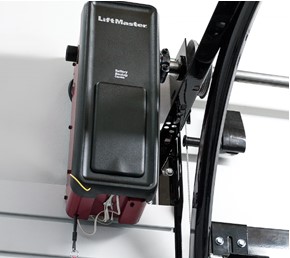
When you start to put together your plans for building a new garage, you start thinking about the garage door and the door opener. Many of the openers that people are familiar with tend to be the ones that are installed over the center of the door. However, those who have a substantial amount of space above the door might be wondering if they should use another option instead. There is a great option – a wall-mounted garage door opener. It could be a fantastic solution.
Let’s learn more about the wall-mounted option, the space you need, and why you might want to use it.
What Does Having an Opener Installed Beside the Door Mean?
People may want to use this type of opener when they have cathedral ceilings in the garage. In cases where the ceiling is at least 10 feet high, this has the potential to be a good option. You want to make the most out of the space you have available in the garage, and using a wall-mounted garage door opener provides you with ample room above. You could use this for storage space, if you choose. Garage doors are typically between seven and eight feet high, which could leave you with quite a bit of overhead storage room.
Most of the door openers today are centrally mounted. These are called “trolley” type openers. The alternative option is the “Jackshaft”. It measures 16.25 inches high by 6.0 inches wide by 6.75 inches deep (41 cm X 15 cm X 17 cm).
This type of garage door opener is very safe, and it features the photoelectric reversal system just as the trolley type openers have. It also works with a remote control, just like the other type of garage door opener. As with all the quality openers on the market today, the remote utilizes Security+ 2.0. This will ensure that no one can pick up the remote control’s signal, as the codes will change each time you use it. This will provide you with an added measure of safety.
The opener will also have a three-button wall control panel, and you can use a backup battery for it, if needed. This can be quite helpful in instances when the power is out for a long time. One of the other great features of this type of door opener is that it can work with MyQ technology, just like the trolley style openers. This means you can open and close the garage door from another device that you have connected to the web, such as your laptop, tablet, or even your smartphone.
When Should You Use This Type of Door Opener?
In cases where you have a floor-to-ceiling distance in the garage that is more than 10ft (3m), and the garage door is 7ft (2.1m) high, you should utilize a wall-mounted garage door opener. In addition, if you happen to have a sloped or cathedral ceiling, you will find that the wall-mounted opener is a good idea.
Using a center-mounted system with this door and garage height would be a bad idea. it would require hanging the motor unit about 2ft from the ceiling, and the brackets needed would be extremely long. Over time, the vibrations from the movement of the door could loosen the support structure, which could be dangerous. The wall-mounted option is the best choice in this circumstance.
Always make sure that you have enough space. This means at least eight inches (20 cm) on one side of the door. Also, if you have torsion hardware, you have to make sure you are using a solid shaft to hold the springs and not a hollow tube.
Regardless of the type of door you use, you need to make sure that it has proper balance. This ensures easy opening and closing, even if you were to do it by hand. The weight of the door should feel between eight and ten pounds (3.5 and 4.5 kg).
Want to Know More?
You can contact us at 705-721-7909. We understand garage doors and can provide you with the info you need, and an online quotation.
Make sure you check out the design center and our image gallery.








Add new comment